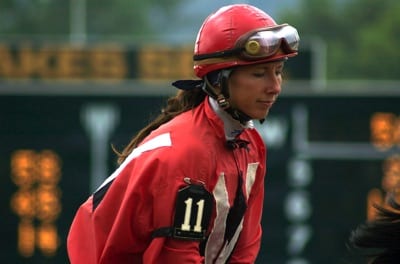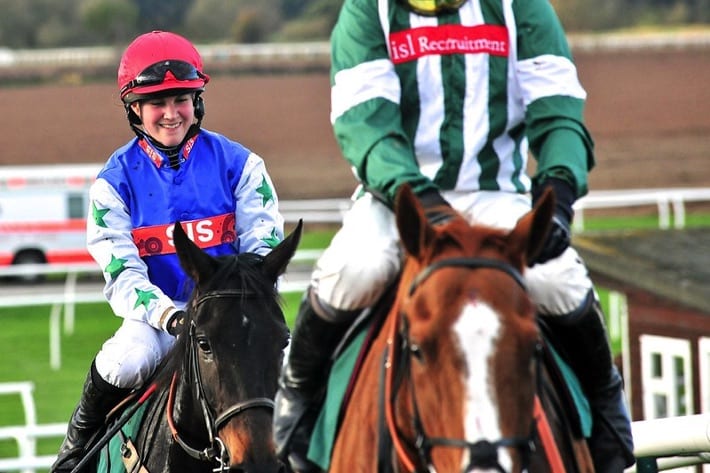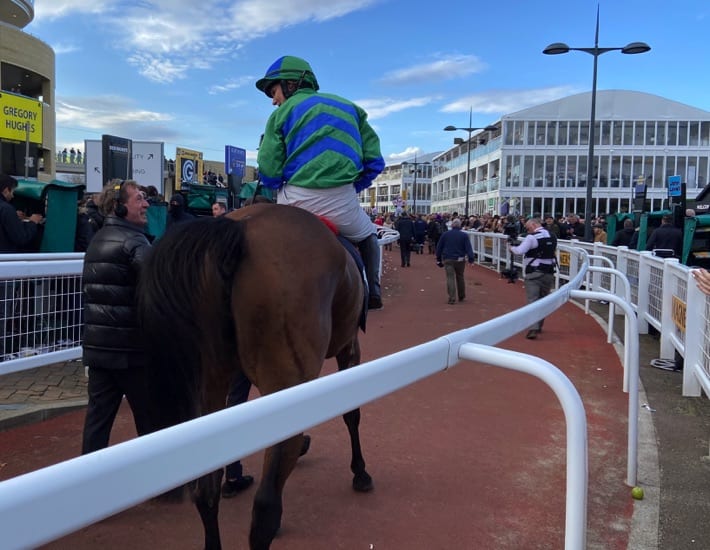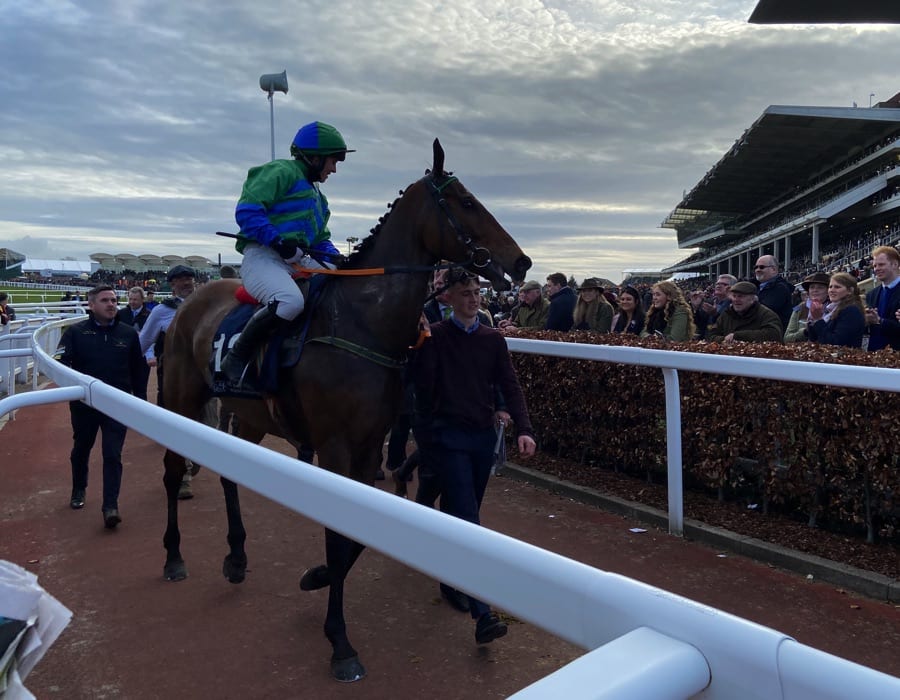
Female jockeys are, gradually, being looked on in the same way as their male counterparts in the world of horse racing. The likes of Rachael Blackmore, Bryony Frost and Lizzie Kelly were at the forefront of the modern day movement of female jockeys to the extent that they were gradually just referred to as jockeys without the ‘female’ in front of it.
One race in which women still have a long way to go in, however, is the Grand National. Billed as The World’s Greatest Steeplechase, the event, which is hosted at Aintree Racecourse on Merseyside, is a stern test of both jockeys and their horses. No female jockey has yet won the race, but that’s perhaps to be expected considering a smaller percentage even ride it to begin with.
The History of Female Jockeys in the Grand National

Part of the trouble with discussing female jockeys and the Grand National is that they weren’t allowed to take part in it during the first hundred plus years of the race’s existence. The Grand National was run for the first time in 1839, but it wasn’t until the passing of the Sex Discrimination Act in 1975 that women were officially allowed to join the race.
The Act was designed to protect men and women from discrimination on account of either their sex or their marital status. Even once passed, the Act didn’t come into effect until two years later, meaning that the first moment that a female jockey was able to enter the Grand National was in 1977. Whilst it certainly led to females entering the race, the floodgates hardly opened.
1977: Charlotte Brew is the First Female Jockey to Enter the Grand National
In fact, just one female jockey entered the race in 1977 when Charlotte Brew rode Barony Fort, making history in the process. She was twenty-one years old at the time, having been given the horse for her eighteenth birthday. Her parents were hunters that enjoyed point-to-point racing, so a move for her into the world of racing was seemingly inevitable.
In just her second race on Barony Fort Brew entered the Foxhunters’ Chase at Aintree in 1976. She finished fourth in the race, meaning that she qualified for a place in the following season’s Grand National. On the day of the race, she was given her own dressing room, before Barony ran well but began to tire in the race itself.
Four from home the horse that Charlotte Brew and Barony Fort had been following pulled up, with Barony deciding that he’d do the same thing. It meant that Brew was unable to finish the course, though even she had the headlines would have been taken by Red Rum winning the event for the third time. Brew ran at Aintree again in 1982 but was unseated.
1988: Three Women Enter the Race
As the 1970s turned into the 1980s, female jockeys began to become a more common occurrence in the Grand. National. When Charlotte Brew returned to the course in 1982, she did so alongside Geraldine Rees, seeing two women enter the race for the first time. Rees did something that Brew, Jenny Hembrow and Linda Sheedy had been unable to: finish the race.
Her eighth place finish meant that she became the first woman to actually complete the Aintree course during the National, putting herself into the history books alongside Brew. It was, perhaps, the catalyst that was needed to see more female jockeys decide to take on the course, with 1983 seeing Rees return and race alongside Joy Carrier.
Yet it was 1988 that the idea of female jockeys racing in the National could no longer be dismissed as something of a frivolous activity, given that three women entered the race. Penny Ffitch-Heyes rode Hettinger, Venetia Williams took on Marcolo and Gee Armytage attempted to beat the men with Gee-A. None of them managed to finish the race.
Even so, the glass ceiling that they broke through was arguably more important to the cause of female jockeys than if any of them had finished the course. They were able to prove that women entering the race was now just a normal occurrence, having battled sexism alongside all of the other obstacles to make it that far. Gee Armytage did so after winning two races during the Cheltenham Festival, proving her mettle.
1994: Women Begin to Place
There was only one female jockey that took part in the Grand National in the 1990s, but she was notable for finishing higher in the race than any other woman before her. Rosemary Henderson rode Fiddlers Pike in the 1994 renewal, finishing fifth in the process. It took another eleven years for a female jockey to ride in the race again, with Carrie Ford also finishing fifth.
Prior to 2021, the best performance by a female jockey came in 2012 when Katie Walsh rode in the race for the first time. She took Seabass to Aintree and finished third, ensuring that female jockeys would once and for all not be looked down upon by the horse racing industry.
2021: First Female Grand National Winner
In 2021, Rachel Blackmore became the first woman to win the Grand National. She rode the Irish trained Minella Times to a historic victory, winning by 6 1/2 lengths.
The Normalisation of Female Jockeys in the National

There were more female jockeys in the Grand National in the twenty years after the turn of the millennium than there were in the twenty-three years before it. It demonstrates, perhaps, the manner in which it has been a long journey for female jockeys but that owners and trainers are far more trusting of them in the more modern, enlightened times.
When Nina Carberry rode Character Building to a fifteenth place finish in 2011, she became the first women to have ridden in the race three times. She went on to ride in it three more times, though she never bettered her second outing when she finished seventh on Character Building. Carberry blazed a trail where the likes of Walsh and Rachael Blackmore would follow.
In the modern era of racing, female jockeys entering the Grand National don’t make headlines in the same way that they did during the 1970s and 1980s. There is less casual sexism around, with most punters not even thinking twice before betting on a female jockey. It is felt by many that it is just a matter of when a female jockey will win the race rather than if.
How Female Jockeys Have Fared Over the Years
In order to best demonstrate the manner in which female jockeys have improved in the Grand National over the years, here’s a look at the number of women that took part in each year there was a female jockey in the race, as well as their finishing positions:
| Year | Number of Female Jockeys | Finishing Position |
|---|---|---|
| 1977 | 1 | Did Not Finish |
| 1979 | 1 | Did Not Finish |
| 1980 | 1 | Did Not Finish |
| 1981 | 1 | Did Not Finish |
| 1982 | 2 | 8th / Did Not Finish |
| 1983 | 2 | Did Not Finish / Did Not Finish |
| 1984 | 1 | Did Not Finish |
| 1987 | 1 | Did Not Finish |
| 1988 | 3 | Did Not Finish / Did Not Finish / Did Not Finish |
| 1989 | 1 | Did Not Finish |
| 1994 | 1 | 5th |
| 2005 | 1 | 5th |
| 2006 | 1 | 9th |
| 2010 | 1 | 7th |
| 2011 | 1 | 15th |
| 2012 | 2 | 3rd / Did Not Finish |
| 2013 | 1 | 13th |
| 2014 | 1 | 13th |
| 2015 | 1 | 16th |
| 2016 | 2 | Did Not Finish / Did Not Finish |
| 2017 | 1 | 19th |
| 2018 | 3 | 5th / 12th / Did Not Finish |
| 2019 | 2 | 10th / Did Not Finish |
| 2020 | n/a | Cancelled |
| 2019 | 3 | 1st / 14th / Did Not Finish |
As you can see, the number of female jockeys that did not finish the race was eighteen between 1977 and 2019, whilst the number that did manage to get their horse all the way around the course was fourteen. The interesting thing is that this is heavily weighted towards the more recent end of the spectrum, with thirteen of those fourteen coming since 1994.
What we can’t know is why that is, exactly. Was it because the course is now safer than it was in years gone by? Is it due to the professionalisation of female jockeys meaning that they’re better prepared for the tricky obstacles? Or was it simply the Roger Bannister effect, wherein one female jockey finishing fifth gave the others the confidence and belief that it could be done?
The Future of Women in the National

At the time of writing, only one female jockey has won the Grand National. The second best finish was third place for Seabass and Katie Walsh in 2012. Yet many believe that it truly is only a matter of time until more female jockeys take home the prize. The main thing that will need to change is the attitude of owners and trainers.
A study of the previous fourteen season’s worth of races was carried out in 2018, with the analysis of the data showing that female jockeys are just as able as their male counterparts when riding horses of similar abilities. The only difference was that only one ride in one hundred events at the highest level of the sport was given to a female jockey.
In fact, the work carried out by Vanessa Cashmore showed that female performance was actually slightly improved over their male counterparts when it came to jump racing. She said that her desire was to ‘change public perceptions about the performance of female jockeys’. The perception of female jockeys being less likely to win is based on them getting poorer horses to ride.
Reading the words of the six women who had managed to finish the Grand National prior to the 2019 renewal, you get a sense of people who are proud of their achievements but determined for their fellow women jockeys to go one step further. In terms of the future of female jockeys, the ultimate aim will be for more to win the National in the future.
Yet equally as important is the idea of the profession becoming one of genuine equality. Female jockeys will only truly feel as though they’re being taken seriously when owners and trainers employ as many of them as they do male jockeys. It’s a long road ahead, but the women who have blazed a trial for others to follow will think it’s one worth treading.